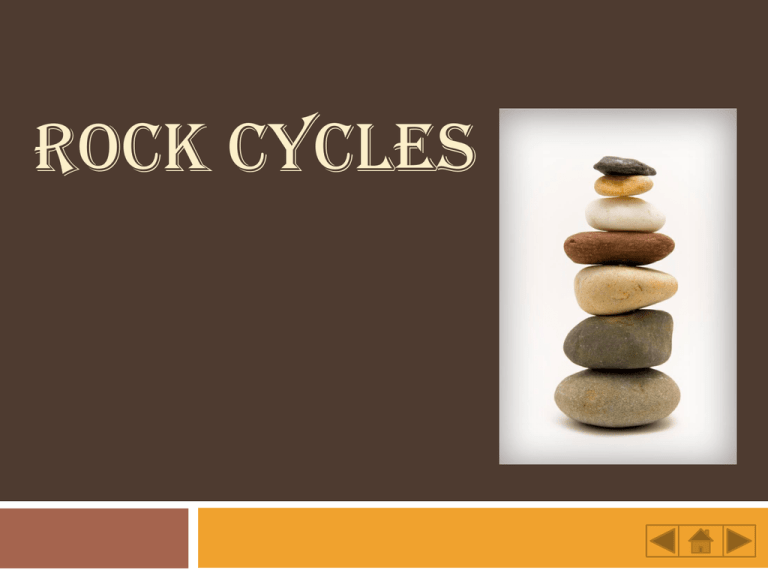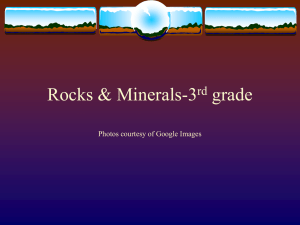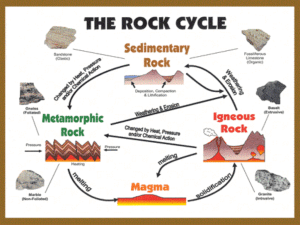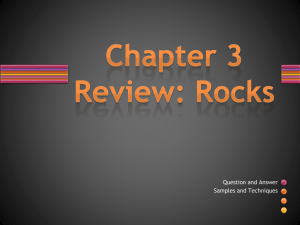ROCK CYCLES - Personal.kent.edu
advertisement

ROCK CYCLES The Rock Cycle The Rock Cycle Introduction Lesson Quiz Rocks are always changing and moving throughout the different phases of the rock cycle. Igneous Rocks The Rock Cycle Igneous Rocks Introduction Lesson Quiz Igneous Rocks o Introduction Igneous Rocks are formed when molten magma becomes solid. o o o Lesson There are two kinds of igneous rocks: o o Quiz Molten- melted Magma on the surface of the Earth is called lava Intrusive Igneous Rocks- magma becomes solid underground. Extrusive Igneous Rocks-lava cools and becomes a solid on Earth’s surface. Igneous Rocks o Introduction o o Lesson Quiz Intrusive Igneous Rocks have large grains and may be various colors. Examples: granite, gabbro Extrusive Igneous Rocks have small grains and also, may be various colors. o Examples: basalt, pumice Sedimentary Rocks The Rock Cycle Sedimentary Rocks Introduction Lesson Quiz Sedimentary Rocks o Introduction Sedimentary Rocks are layered rocks formed from fragments and broken bits of rock. o Lesson o Quiz These bits of broken rock are a result of weathering and erosion. The fragments of rock eventually cement and compact together to form a layered rock. Sedimentary Rocks o Introduction The size and texture of sedimentary rocks depend on what kind of fragments make up the rock. o Lesson Quiz Sedimentary Rocks can be made of sand, gravel, broken seashells, or even just layers of mud. Metamorphic Rocks The Rock Cycle Metamorphic Rocks Introduction Lesson Quiz Metamorphic Rocks o Introduction o Lesson o When the sedimentary or igneous rocks are pushed down into the ground, they will be under greater pressure and heat. This will cause the crystals of the sedimentary rocks to change and become a new kind of rock, called metamorphic rock. There are two kinds of metamorphic rocks: o Quiz o Contact Metamorphic Rocks- forms when magma inside the Earth comes up into an already existing rock and “bakes” it. Regional Metamorphic Rocks- forms when rocks already deep inside the Earth change because of heat and pressure Metamorphic Rocks o Introduction Metamorphic Rocks may be foliated or nonfoliated: o o Lesson o Quiz Foliated means that the rocks have recognizable parallel bands. Example: slate, schist Nonfoliated means that the rocks do not have these bands; they appear smooth. o Example: quartzite, marble Are you ready for a quiz? Introduction Lesson Quiz Yes No. I need to review the material. Quiz Introduction Question #1. Which kinds of rocks are formed from molten lava? Sedimentary Rocks Lesson Metamorphic Rocks Quiz Igneous Rocks Quiz Correct! Introduction Lesson Quiz Igneous Rocks are formed from either molten magma inside the Earth, or molten lava outside the Earth. Quiz Introduction Question #2. What causes metamorphic rocks to form? Heat and Weather Lesson Heat and Pressure Quiz Climate and Pressure Quiz Correct! Introduction Lesson Quiz The pressure from rocks above will push the metamorphic rock farther down, where it will be exposed to greater heat. This combination of heat and pressure will cause the crystals in the rock to change and become a new rock: metamorphic rock. Quiz Introduction Lesson Question #3. Bits and pieces of rock form sedimentary rocks? Where do these fragments of rock come from? The underlying molten magma Weathering and Erosion Quiz Quiz Correct! Introduction Lesson Quiz Weathering occurs first; wind, water, etc. cause bits and pieces of rock to break off. Then erosion occurs when these fragments are carried away and deposited somewhere else. Quiz Introduction Question #4. What kind of igneous rocks form underground? Extrusive Igneous Rocks Lesson Cemented Igneous Rocks Quiz Intrusive Igneous Rocks Quiz Correct! Introduction Lesson Quiz Intrusive Igneous Rocks are formed from molten magma becoming solid underneath the Earth’s surface. Quiz Introduction Lesson Question #5. ___________forms when magma inside the Earth comes up and “bakes” the nearby rocks. Contact Metamorphism Regional Metamorphism Quiz Local Metamorphism Quiz Correct! Introduction Lesson Quiz Contact Metamorphism occurs when magma comes up into another rock and bakes the nearby rocks. Quiz Introduction Lesson Question #6. Are rocks always changing and moving throughout the different phases of the rock cycle? Yes. No. Quiz Quiz Introduction Lesson Quiz Correct! The Rock Cycle is a never-ending process. For example: o An extrusive igneous rock is exposed to weathering. o A channel of water carries this weather igneous rock down a slope into a lake. o Layers of weathered igneous rock build up in the lake and eventually are cemented together. o Layer after layer forms on top of the igneous rock and it becomes a layered sedimentary rock. o After much time, this sedimentary rock is pushed down into the Earth and becomes exposed to heat. o This heat and pressure cause the grains of the rock to change and become a new kind of rock: metamorphic rock. o This metamorphic rock, over time, continues to be pushed farther into the Earth until it finally melts into magma. o This magma may eventually come in contact with a way “out”, such as a volcano. o The magma flows out of the volcano in the form of lava, becomes solid, and forms and extrusive igneous rock. o And the cycle starts over. The End OOPS! Try Again! Introduction Question #1 Question #2 Lesson Question #3 Question #4 Quiz Question #5 Question #6 The End Click for Works Cited Works Cited Academic Content Standard Grade 6 Earth and Space Sciences -Earth Systems 1. Describe the rock cycle and explain that there are sedimentary, igneous, and metamorphic rocks that have distinct properties (e.g., color, texture) and are formed in different ways. http://www.windows.ucar.edu/tour/link=/earth/geology/rocks_intro.html http://www.beyondbooks.com/ear82/7.asp http://office.microsoft.com/en-us/clipart









